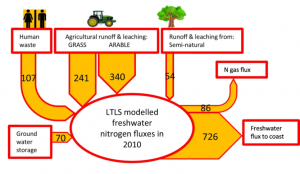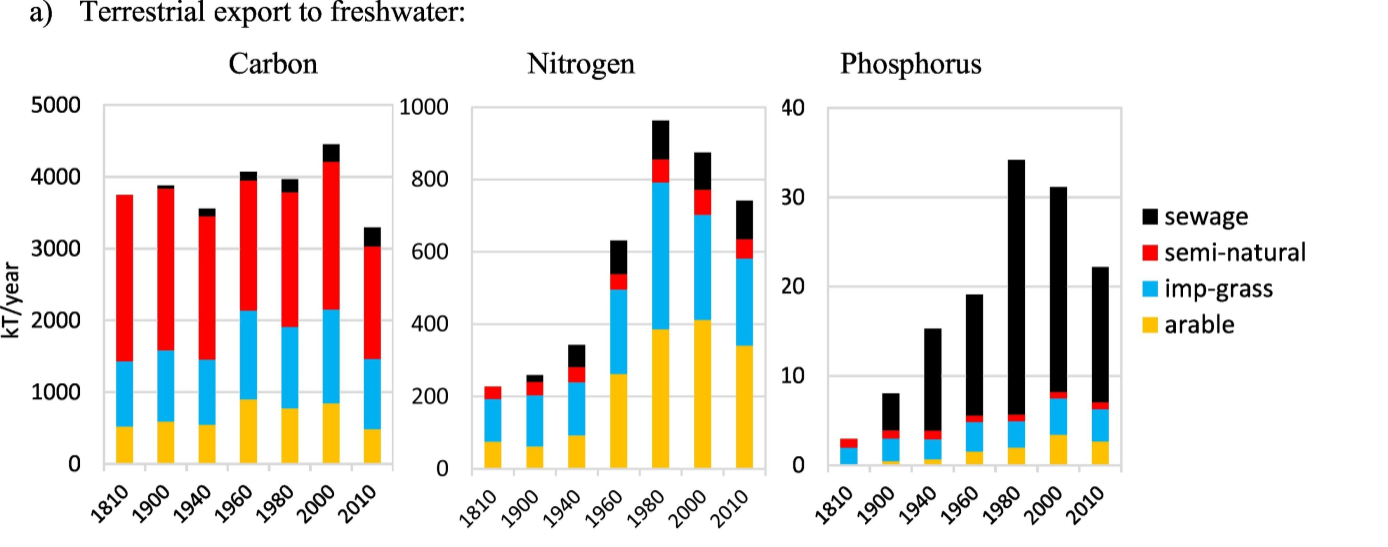 Our recent research has explored how long-term changes in land use, agriculture, atmospheric pollution and human waste generation and management has changed the flows of nutrients through our waterways.
Our recent research has explored how long-term changes in land use, agriculture, atmospheric pollution and human waste generation and management has changed the flows of nutrients through our waterways.
Centuries of nutrient change
The past two centuries have seen huge changes in our landscapes and ways of life that have driven big changes in the flows of macronutrients, carbon nitrogen and phosphorus, in our environment. Agricultural expansion has changed plant cover, disrupting plant-soil nutrient cycles, and with the Green Revolution and the widespread adoption of inorganic fertilizer use came large additions of nitrogen and phosphorus to the environment. Natural ecosystems too have been affected by large additions of nitrogen from atmospheric pollution, driven by rising fertilizer use and fossil fuel burning. Rising populations, the introduction of the toilet, and the use of new products in the home such as detergents, have also meant that wastewater has changed the flow of nutrients around our environment.
A nutrient puzzle
All this simultaneous, long-term, widespread change presents us with puzzle – how can we understand how these various drivers have contributed to nutrient cycle change and the consequences for terrestrial and aquatic ecosystems, and what can we learn that helps us manage nutrient flows and the negative knock-on effects in future? Computer modelling offers us a way to unpick this puzzle.
The Long-Term Large-Scale project, funded by the Natural Environment Research Council’s Macronutrient Research Programme, brought together a diverse set of researchers to build an integrated model that interconnects nutrient processes from atmosphere to plants and soils to waterways. John Quinton and Jess Davies were part of this modelling effort contributing key components in plant-soil biogeochemical and soil erosion modelling.
Modelling the past to understand the future
The paper, published in Science of the Total Environment, communicates some of our findings from a freshwater perspective. Our modelling analysis indicates that the rapid increase in the use of agricultural fertilisers after the second world war, and the rising human population, led to a rapid rise in nitrogen and phosphorus fluxes to rivers, with nitrogen export to rivers quadrupling and phosphorus increasing by a factor of 10 (see figure exert below). During this period, the modelling shows that the dominant source of nitrogen to rivers switched from intense grasslands to arable, the dissolved N export to rivers quadrupled, and P from human waste entering our waterways increased by ~600%, despite waste water treatment.
This work highlights the extent to which we as humans have modified our nutrient world in the past, but it can also help us make a better future. This research and the modelling tools produced can help inform national nutrient budgets and targeting of water quality measures, and help us set realistic targets for nutrient export and water quality status.

Exert from figure in Bell et al 2021: Export of carbon, nitrogen and phosphorus to UK waterways from soils 1800–2010.
If you are interested in other findings form the Long-Term Large Scale Macronutrient Change project, more outputs from the project are listed below:
- Measured estimates of semi-natural terrestrial NPP in Great Britain: comparison with modelled values, and dependence on atmospheric nitrogen deposition. Edward Tipping, Jessica A. C. Davies, Peter A. Henrys, Susan G. Jarvis, Edwin C. Rowe, Simon M. Smart, Michael G. Le Duc, Robert H. Marrs, Robin J. Pakeman (2019) Biogeochemistry 144, 215–227. https://doi.org/10.1007/s10533-019-00582-5
- Impact of two centuries of intensive agriculture on soil carbon, nitrogen and phosphorus cycling in the UK. S.E.Muhammed, K. Coleman, Lianhai Wu, V.A. Bell, J.A.C. Davies, J.N. Quinton, E.J. Carnell, S.J. Tomlinson, A.J. Dore, U. Dragosits, P.S. Naden, M.J. Glendining, E. Tipping, A.P. Whitmore (2018). Science of the Total Environment 634, 1486–1504. https://doi.org/10.1016/j.scitotenv.2018.03.378
- Long-term increases in soil carbon due to ecosystem fertilization by atmospheric nitrogen deposition demonstrated by regional-scale modelling and observations. E. Tipping, J. A. C. Davies, P. A. Henrys, G. J. D. Kirk, A. Lilly, U. Dragosits, E. J. Carnell, A. J. Dore, M. A. Sutton & S. J. Tomlinson. Scientific Reports 7, Article number: 1890 (2017) http://dx.doi.org/10.1038/s41598-017-02002-w
- 150 years of macronutrient change in unfertilized UK ecosystems: Observations vs simulations. JAC Davies, E Tipping, AP Whitmore. Science of the Total Environment (2016) http://dx.doi.org/10.1016/j.scitotenv.2016.03.055
- Long-term P weathering and recent N deposition control contemporary plant-soil C, N, and P. J.A.C. Davies, E.Tipping, E.C. Rowe, J.F. Boyle, E.Graf Pannatier, V. Martinsen (2016) Global Biogeochemical Cycles 30, 231-249. https://doi.org/10.1002/2015GB005167